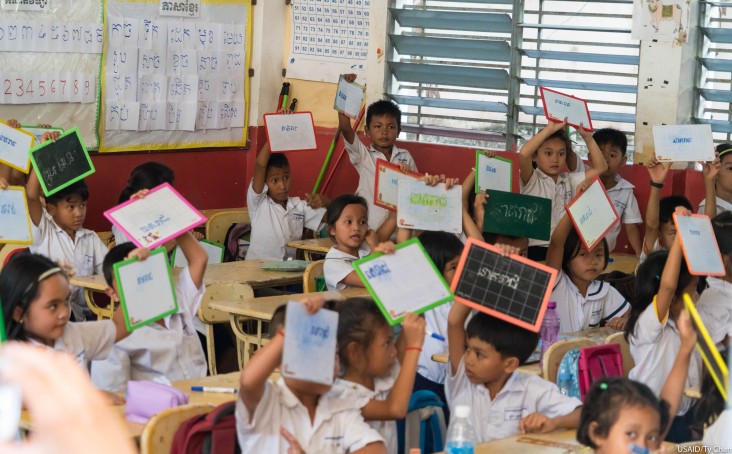Speeches Shim

EDUCATION
USAID is supporting Cambodia’s efforts to improve education. With a 97 percent primary net enrollment rate in 2020, the Ministry of Education, Youth and Sport (MoEYS) is close to achieving universal access to primary education. Cambodia has also strengthened female enrollment and achieved gender parity (0.98) in primary education. The government demonstrated its commitment by allocating 18 percent of the national budget to education (2021). While MoEYS has introduced rigorous reforms to the national curriculum, teacher training, and school governance, Cambodia still struggles to maintain national, equitable student learning outcomes. Recent assessments show that only 32 percent of male third graders are proficient in Khmer literacy, compared to 48 percent of their female peers. Meanwhile, only 8 percent of 15-year-old students achieved the minimum level of reading proficiency, while just 10 percent achieved minimum proficiency in mathematics. Drop-out rates in secondary schools remain high.
RESULTS
Over the past five years USAID has:
- Developed and distributed (directly and indirectly) over 1 million hard and soft copies of reading materials, including teacher guides, student supplemental books and story books for upper-preschool, grade 1, and grade 2 students.
- Trained over 6,000 teachers in 2,500 primary schools, reaching more than 220,000 students.
- Provided emergency assistance to address the impact of COVID-19 in the education sector. This included the production of video lessons and e-lessons; the provision of hygiene supplies; resources for students with disabilities; and the launch of a back-to-school campaign for children returning to school.
- Promoted robust, gender-equitable leadership training at the national and subnational levels, including professional development opportunities for hundreds of women leaders.
- Improved the capacity of several hundred Ministry officials and decision-makers by focusing on their ability to research, analysis, and formulate policy.
- Leveraged funding from bilateral and multilateral partners, including the Global Partnership for Education, to support USAID’s core development principles and Cambodia’s education priorities.
CHILD PROTECTION
Photo: USAID provides direct support at the community level to strengthen vulnerable families and prevent unnecessary child-family separation.
USAID supports Cambodia’s efforts to improve child development and strengthen child protection services by addressing violence against children and transitioning away from a reliance on residential care institutions. With a national goal to reduce the number of children living in residential care by 30 percent, the Ministry of Social Affairs, Veterans and Youth Rehabilitation is working to ensure that systems are in place to prevent child and family separation and reintegrate children that have been separated into safe, nurturing family care. USAID assistance contributes to the strengthening of Cambodia’s Child Protection System through the formulation and operationalization of national policies as well as the national roll-out of digital case management and inspection systems. This includes support to direct prevention and response services through partners.
RESULTS
Over the past five years USAID has:
- Strengthened family care for over 23,000 children (47% girls). Over 1,600 (nearly half of whom are female) children were returned to family care from residential institutions and at least 4.9 million people were reached through the USAID-supported Strong Family Campaign that reinforces the importance of children remaining in family care.
- Provided direct support to over 70 residential care institutions (RCI) about the importance of transitioning to family-based care. As a result, 24 RCIs have already refocused their activities to provide holistic services to families and communities.
- Supported 750 vulnerable households in 15 provinces through child-sensitive cash transfers and over 600 households through a livelihoods program to prevent child and family separation and mitigate pandemic impact.
- Advocated for and supported domestic resource mobilization and national budget prioritization, resulting in the recruitment of 16 social workers into the civil service, marking the first time a social worker is on government payroll.
- Assisted the government to endorse and roll out the Child Protection Information Management System, a digital inspection system, and a digital case management system.
- Strengthened the government’s capacity to coordinate, align, and oversee subnational actors and more than 60 NGOs working in system strengthening and service provision.
Last updated: April 22, 2022


Comment
Make a general inquiry or suggest an improvement.